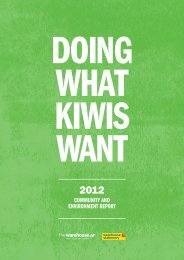ar11-lr-final
You also want an ePaper? Increase the reach of your titles
YUMPU automatically turns print PDFs into web optimized ePapers that Google loves.
Notes to and forming part of the Financial Statements – continued<br />
For the 52 WEEK period ended 31 July 2011<br />
4. Financial Risk Management (CONTINUED)<br />
(c) Credit risk<br />
Credit risk arises from the financial assets of the Group which are exposed to potential counter-party default, with a maximum<br />
exposure equal to the carrying amount of these assets. In the normal course of business the Group incurs credit risk from trade and<br />
other receivables, electricity derivatives and transactions with financial institutions.<br />
GROUP GROUP PARENT PARENT<br />
NotE 2011 2010 2011 2010<br />
$000 $000 $000 $000<br />
Maximum exposures to credit risk at balance date are:<br />
Cash and cash equivalents 18 23,016 101,226 2,526 2,530<br />
Trade and other receivables 21 25,791 19,020 – –<br />
Derivative financial instruments 22 1,138 873 – –<br />
Intercompany advances – – 316,508 316,149<br />
Investment in associate company 27 7,585 5,921 – –<br />
57,530 127,040 319,034 318,679<br />
The Group places cash and short-term investments with high credit quality financial institutions. The Board reviews bank counterparties<br />
and investment limits on an annual basis. The 2011 annual review included an external review of bank counter-party<br />
risk, which lead to changes in the mechanism for determining investment limits based on bank credit ratings being proposed by<br />
management which were then approved by the Board. The Group’s treasury policy specifies maximum credit limits for each bank<br />
counter-party and requires bank counter-parties to have a Standard & Poor’s credit rating of at least A+ (2010: AA-).<br />
The Group performs credit evaluations on customers requiring credit, but generally does not require collateral. In addition, receivable<br />
balances are monitored on an ongoing basis to ensure the Group’s bad debt exposure is not significant. Loans to team members<br />
to purchase shares in accordance with the Group’s share purchase plan are effectively secured as team members are not given the<br />
shares until the advances are fully repaid. Concentrations of credit risk, with respect to trade and other receivables, are limited due<br />
to the minor nature and spread of such accounts.<br />
The Group enters into foreign exchange derivatives, interest-rate derivatives and electricity derivatives within specified policy limits<br />
and only with counter-parties approved by Directors. There are no significant concentrations of credit risk within the Group and<br />
financial instruments are spread amongst a number of financial institutions and electricity providers to minimise the risk of a counter<br />
party default.<br />
The Group’s associate company, The Warehouse Financial Services Limited, offers consumer credit to customers, who potentially<br />
expose the Group to an indirect credit risk. Customers who request consumer credit finance are subject to credit verification<br />
procedures in accordance with Westpac Banking Corporation standards. The amount of capital invested by both the Group and<br />
its associate partner, and the level of bad debt provisions maintained, are also determined in accordance with Westpac Banking<br />
Corporation standards. The Directors are satisfied that these standards are appropriate for the nature and performance of the<br />
business.<br />
(d) Fair values<br />
Except for the fixed rate senior bond (refer note 29), the carrying value of all balance sheet financial instruments approximate their fair value.<br />
• Derivatives are carried at fair value (refer note 1 (p))<br />
• Receivables and payables are short term in nature and therefore approximate to fair value<br />
• Interest bearing bank borrowings and deposits reprice between every 1 to 90 days and therefore approximate to fair value<br />
The methods used to calculate fair value are as follows:<br />
Derivatives<br />
The Group’s derivatives are over the counter derivatives and are classified as tier 2 financial instruments under NZIFRS 7, meaning<br />
that the fair value is calculated using present value or other valuation techniques based on observable market rates.<br />
Fixed rate senior bond<br />
The fair value of the fixed rate senior bond is determined by reference to the quoted market price of debt securities quoted on the<br />
New Zealand stock exchange at balance date (refer note 29).<br />
(e) Derivatives at fair value through the Income Statement<br />
ELECTRICITY PRICING CONTRACTS – ECONOMIC HEDGES GROUP GROUP<br />
Asset/(Liability) NOTE 2011 2010<br />
$000 $000<br />
Opening balance (194) 88<br />
Changes in fair value of financial instruments recognised in the Income Statement 194 (282)<br />
Closing balance 22 – (194)<br />
Notes to and forming part of the Financial Statements – continued<br />
For the 52 WEEK period ended 31 July 2011<br />
5. Segment Information<br />
GROUP REVENUE OPERATING PROFIT<br />
2011 2010 2011 2010<br />
$000 $000 $000 $000<br />
The Warehouse 1,462,912 1,476,219 98,777 112,664<br />
Warehouse Stationery 201,453 193,599 10,103 8,044<br />
Other Group operations 8,320 8,107 5,256 3,341<br />
Inter-segment eliminations (4,908) (5,230) – –<br />
1,667,777 1,672,695 114,136 124,049<br />
Unallocated (expenses)/revenue<br />
Gain on disposal of property 1,470 –<br />
Changes in fair value of financial instruments 194 (282)<br />
Equity earnings of associate 3,575 2,808<br />
Earnings before interest and tax 119,375 126,575<br />
Net interest expense (9,845) (7,409)<br />
Income tax expense (31,385) (58,626)<br />
Net profit for the period 78,145 60,540<br />
Operating margin<br />
The Warehouse 6.8% 7.6%<br />
Warehouse Stationery 5.0% 4.2%<br />
Total Group 6.8% 7.4%<br />
The operating margin is calculated by dividing operating profit by revenue.<br />
(a) Operating segments<br />
The Group has two primary operating segments operating in the New Zealand retail sector. The operating segments are managed<br />
separately with their own management, stores and infrastructure. These segments form the basis of internal reporting used by<br />
Management and the Board of Directors to monitor and assess performance and assist with strategy decisions.<br />
The Warehouse<br />
The Warehouse is predominantly a general merchandise and apparel retailer, with 88 (2010: 87) stores located throughout New Zealand.<br />
Warehouse Stationery<br />
Warehouse Stationery is a stationery retailer, with 51 (2010: 47) stores located throughout New Zealand.<br />
Other Group operations<br />
This segment includes the Group’s property operations, which owns a number of stores and distribution centres occupied by the other business<br />
segments. This segment also includes the Group’s corporate function and a chocolate factory, which supplies product to The Warehouse.<br />
Transfer prices between business segments are set on an arm’s length basis in a manner similar to third parties. Segment revenues<br />
and expenses include transfers between segments, which are eliminated on consolidation.<br />
(b) Other segment information<br />
GROUP Depreciation AND amortisation Capital expenditure<br />
NOTE 2011 2010 2011 2010<br />
$000 $000 $000 $000<br />
The Warehouse 32,041 33,307 37,319 22,905<br />
Warehouse Stationery 4,902 4,608 6,161 4,310<br />
Other Group operations 2,829 3,022 24,109 28,454<br />
39,772 40,937 67,589 55,669<br />
Comprising:<br />
Property, plant and equipment 25 31,719 33,080 61,964 49,534<br />
Computer software 26 8,053 7,857 5,625 6,135<br />
39,772 40,937 67,589 55,669<br />
Asset impairment provisions for The Warehouse of $0.044 million (2010: $Nil) and Warehouse Stationery of $0.069 million<br />
(2010: $Nil) were recognised for damaged store fixtures and fittings sustained during the Christchurch earthquakes (refer note 25).<br />
These assets are fully insured for replacement value.<br />
FINANCIAL STATEMENTS 46<br />
FINANCIAL STATEMENTS 47
















